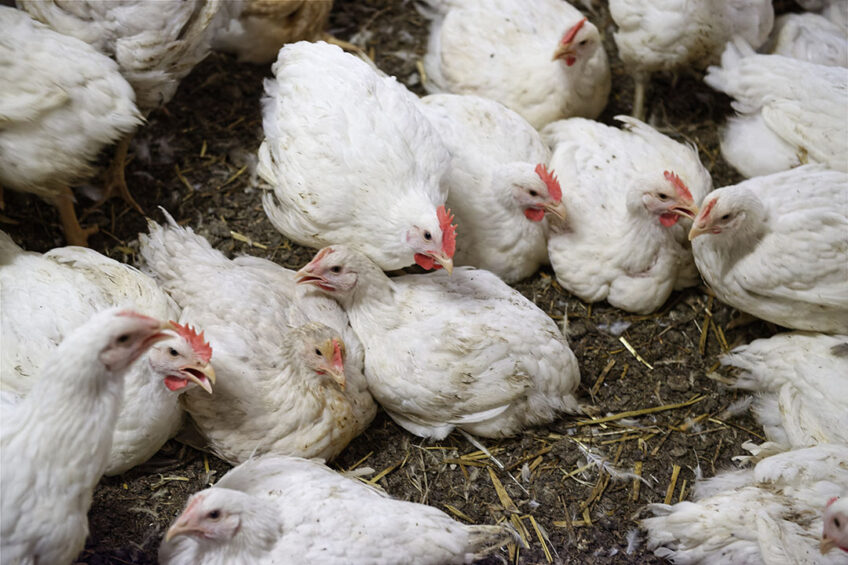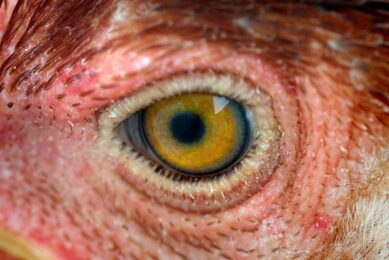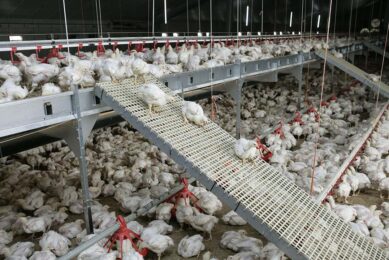Laser enrichment reduces muscle damage in fast-growing broilers

Slow-moving laser projections in a broiler pen, together with the birds’ natural curiosity to follow the light patterns, have shown promising results in reducing woody breast and white striping. Laser enrichment to get the birds on their feet and moving decreased harmful corticosterone levels and improved meat quality.
Woody breast and white striping – myopathies in the pectoralis major muscle of broilers – have become notable meat quality concerns with an estimated annual cost of over US$200 million to the US industry. In addition, woody breast and white striping are widely believed to impact broiler welfare.
Woody breast is described as an exudative and pale in colour texture concern associated with hard, rigid fillets and connective tissue replacement of muscle fibres. White striping is a visual issue characterised by infiltration of white striations of fat and connective tissue parallel to muscle fibres. Woody breast and white striping are also linked to reduced meat colour and water-holding capacity, higher ultimate pH, with increased drip and cooking loss.
Short laser exposure
A research study by Dr Meaghan Meyer at Iowa State University (ISU) introduced a second-generation laser enrichment device to Ross 708 broilers for extended 6 minute periods of exposure to measure the occurrence and severity of woody breast and white striping, breast muscle gene expression, stress and muscle damage serum markers, as well as outcome-based animal welfare indicators.
Meyer recently graduated with a PhD in Animal Sciences from ISU under the supervision of Dr Elizabeth Bobeck and Dr Anna Johnson and her research focused on poultry behaviour, welfare, meat quality and nutrition.
Previous studies showed that circulating corticosterone as a stress biomarker was significantly higher in birds affected by woody breast and white striping, indicating that these muscle disorders affect broiler welfare and behaviour. Thus, in this study it was hypothesised that factors affecting broiler welfare, including environment and husbandry, may contribute to breast muscle quality and induce myopathy.
A total of 1,360 mixed sex Ross 708 broilers were selected and housed in 40 pens of 34 birds/pen across 2 rooms in a barn. One room contained 20 laser-enriched pens and the other room contained 20 control pens without laser enrichment. The lasers were projected in the direction of the pen floors and moved slowly in a random, circular pattern for 6 minutes, 4 times a day for the entire trial.
Breast blister and footpad dermatitis were scored in birds. Gait score, weight gain, average body weight, feed intake and feed conversion ratio were also recorded. Blood samples were taken from 56 randomly selected broilers to measure corticosterone, myoglobin, and troponin levels. The width of the complete pectoralis major muscle was measured, and the left breast fillet dissected and weighed. Each fillet was assigned woody breast and white striping scores and the water-holding capacity was also calculated. In addition, RNA was isolated from 60 breast muscle samples and analysed.
Bloodwork findings
Corticosterone increases in the circulation because of stressors such as increased temperature, restraint, transport, greater stocking density and high ammonia levels. Therefore, it is one of the most common physiological parameters used to measure stress. In this study, laser treatment decreased serum corticosterone at all the timepoints analysed.
Myoglobin is a cardiac and skeletal muscle-specific protein released during muscle injury or damage and is a potential biomarker for woody breast and white striping. In this study, serum myoglobin increased in laser-enriched broilers in week 5 but then decreased in weeks 6 and 7.
Troponin is a fast-twitch skeletal muscle-specific protein which regulates calcium binding for muscle contraction and indicates muscle damage when present in serum. In this study, serum troponin decreased in week 5 but then increased in week 7. Among the laser-enriched broilers pectoralis major width increased by 1.08 cm, breast fillet weight increased by 30 g, and the height of the left breast fillet increased by 0.42 cm.
The water-holding capacity of the meat positively decreased in the laser-enriched breast fillets. Plus, moderate white breast scores increased, and severe white breast scores decreased among the laser-enriched broiler breasts.
Molecular analysis
Myostatin is a negative regulator of skeletal muscle growth, and its expression decreases in the breast muscles of commercial broilers compared to lower-yielding, slower-growing breeds. Insulin-like growth factor 2 increases in fast-growing broiler breast muscle due to post-hatch muscle growth and embryonic muscle development. In this study, the expression of myostatin, insulin-like growth factor 2, muscle regulatory factor 4, and myogenin increased in the breast tissue samples of the laser-enriched broilers. Moreover, laser enrichment reduced markers of stress and muscle damage while improving breast muscle quality and therefore is a potentially effective enrichment for commercial broilers.
These outcomes demonstrated that laser enrichment positively impacted broiler welfare and reduced woody breast and white striping. Since the enrichment device utilised here increased broiler activity, the next step is to consider the potential exercise effects on breast muscle biology. Further study is required to focus on the optimal enrichment area, laser per square foot estimate, impact on low-performing and high-performing flocks, and optimising the duration of laser enrichment.
Join 31,000+ subscribers
Subscribe to our newsletter to stay updated about all the need-to-know content in the poultry sector, three times a week. Beheer
Beheer











 WP Admin
WP Admin  Bewerk bericht
Bewerk bericht